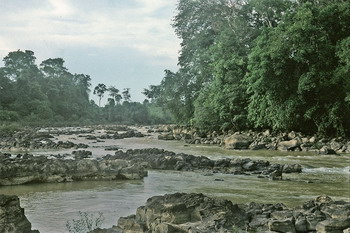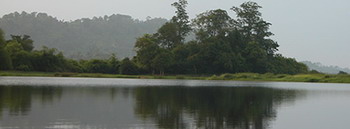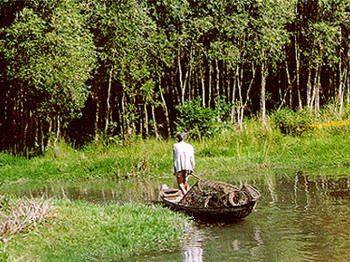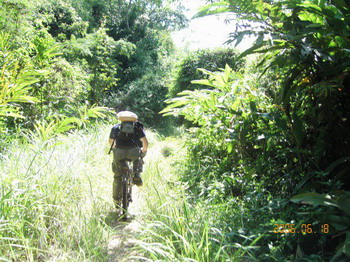Cat
Tien National Park

Alternative site name(s)
Cat Loc, Nam (Bai) Cat Tien, Tay (Bai) Cat Tien
Province(s)
Dong Nai, Lam Dong and Binh Phuoc
Area
70,548 ha
Coordinates
11o21' – 11o48'N, 107o10' – 107o34'E
Distance(s)
From HoChiMinh City
From Nha Trang City
From Da Lat City
Eco-tours
Trekking,
Wildfile, Bird watching… Contact
us for more information
Topography and hydrology

The Nam Cat Tien sector of Cat
Tien National Park is located in Dac Lua commune,
Tan Phu district, Dong Nai province. The Tay Cat
Tien sector is located in Dang Ha commune, Bu Dang
district, Binh Phuoc province. The Cat Loc sector
is located in Tien Hoang, Gia Vien and Phuoc Cat II communes,
Cat Tien district, and Loc Bac commune, Bao Lam district,
Lam Dong province.
The topography of Cat Tien National Park
varies greatly among the three sectors. The Cat Loc sector
is situated at the western extent of the Central Highlands
and, consequently, is rather hilly. Although elevations
only reach 659 m, the hills are relatively steep. The Nam
Cat Tien and Tay Cat Tien sectors are situated in the lowlands
of southern Vietnam, at the foot of the Central Highlands.
The topography of these sectors is characterised by low,
gentle hills, the highest of which reaches an elevation
of 372 m.
The Dong Nai river, the second largest river in southern
Vietnam, flows through the national park, forming the western
boundary of the Cat Loc sector and the eastern boundary
of the Nam Cat Tien sector. The numerous streams
that originate in the national park drain into this river.
The lowlands in the north of the Nam Cat Tien sector are
poorly drained, and support an area of swamps and lakes,
which are fed by seasonal flooding of the Dong Nai river.

Biodiversity values
Cat Tien National Park supports a variety
of habitat types, including primary and secondary lowland
evergreen forest dominated by species in the Dipterocarpaceae;
primary and secondary lowland semi-evergreen forest, dominated
by Lagerstroemia spp; freshwater wetlands with open lakes
and seasonally inundated grasslands, containing Saccharum
spontaneum, S. arundinaceum and Neyraudia arundinacea; flooded
forest, dominated by Hydnocarpus anthelmintica mixed with
Ficus benjamina; and a range of secondary habitat types,
including grassland and areas dominated by bamboo.
Cat Tien National Park was sprayed intensively
with herbicides during the Second Indochina War, and logged
immediately after. In areas of dense bamboo and grass cover,
natural re-growth of trees hardly occurs. Only 50% of the
total area of the national park is classified as evergreen
forest, semi-evergreen forest or mixed forest. Bamboo forest
accounts for 40% of total land cover. The remainder of the
land cover consists of wetlands, grasslands and agricultural
land.
The flora of Cat Tien National Park includes
more than 1,300 species of vascular plants, among which
are 34 species listed in the Red Data Book of Vietnam
and many valuable timber species, such as Afzelia xylocarpa,
Dialium cochinchinensis, Dalbergia oliveri and Pterocarpus
macrocarpus.
To date, 76 mammal, 320 bird, 74 reptile, 35 amphibian,
99 fish and 435 butterfly species have been confirmed to
occur at the national park; and there are unconfirmed records
of an additional 32 mammal, 19 bird, nine reptile, four
amphibian, 31 fish and four butterfly species. The species
confirmed to occur include 16 mammals, 15 birds and eight
reptiles that are globally threatened.
Cat Tien is one of the most important
sites in Vietnam for the conservation of large mammals.
Among the large mammal species that have been confirmed
to occur at the national park are Asian Elephant Elephas
maximus, Lesser One-horned Rhinoceros, Eurasian Wild Pig
Sus scrofa, Sambar Cervus unicolor and Gaur Bos gaurus,
of which the later three species reportedly occur at high
densities relative to other areas in Vietnam. Of the large
mammal populations at Cat Tien National Park,
the most globally significant one is that of Lesser One-horned
Rhinoceros. This is the only known population of the species
in mainland South-East Asia and the only known population
of the sub-species R. s. annamiticus in the world. However,
the population size and range of this species at the national
park has declined over the last two decades, and current
estimates put the population size at seven or eight individuals
and the range at 6,500 ha.
Cat Tien National Park is also a nationally
important site for primate conservation, supporting populations
of several primates of conservation concern, including Black-shanked
Douc Pygathrix nigripes, Northern Pig-tailed Macaque Macaca
leonina and Yellow-cheeked Crested Gibbon Hylobates gabriellae.
Cat Tien National Park is situated in
the South Vietnamese Lowlands Endemic Bird Area (EBA), and
supports populations of all three bird species that characterised
this EBA: Orange-necked Partridge Arborophila davidi, Germain's
Peacock Pheasant Polyplectron germaini and Grey-faced Tit
Babbler Macronous kelleyi (Stattersfield et al. 1998, Polet
and Pham Huu Khanh 1999a). Cat Tien is
also an important site for the conservation of waterbirds.
Among the globally threatened waterbird species that have
been recorded at the site are White-shouldered Ibis Pseudibis
davisoni, White-winged Duck Cairina scutulata and Lesser
Adjutant Leptoptilos javanicus (Polet and Pham Huu Khanh
1999a). Cat Tien National Park includes
two Important Bird Areas: Nam Cat Tien
and Cat Loc.
Another globally threatened species that occurs at Cat
Tien National Park is Siamese Crocodile Crocodylus
siamensis. A survey for this species in 1999 found no evidence
for its continued occurrence at the national park. However,
with the assistance of the WWF project, 30 captive-bred
Siamese Crocodiles were subsequently released into the national
park, after DNA tests confirmed that they were of pure stock.
Other documented values
The forest at Cat Tien National
Park has an important role in protecting the watershed
of the Tri An reservoir, one of the most important sources
of water for domestic and industrial use in Ho Chi Minh
City
.
In addition, Cat Tien National Park receives
a growing number of domestic tourists, many of whom visit
on day or weekend trips from Ho Chi Minh City. The national
park is also gaining in popularity amongst specialist foreign
tourists, including birdwatchers. The proximity of the national
park to Ho Chi Minh City, its location on the route between
Ho Chi Minh City and Da Lat city, the well developed tourism
infrastructure at the site, and the ease at which wildlife
can be seen relative to other sites in Vietnam, are all
factors in favour of growth in the tourism sector. However,
management of tourism remains weak, and is certainly posing
a threat to the biodiversity of the national park. There
is, therefore, a need to develop tourism in a controlled
and environmentally sensitive manner.
\
|